

































Problems never end but neither does the ingenuity of Cisco! Following the success of its predecessors, HackIT III took place at the end of July, this time bigger, better and awesome-er than before. This quarter, San Jose, RTP and HackIT's brand new theater, UK, gathered 203 passionate participants to come up with innovative solutions to real problems that Cisco faces everyday. HackIT III's featured category came from an emerging market: Social Data, and as such, featured problems were crowdsourced via Idea Bank.
Speakers
Throughout both days, participants in the Americas had the opportunity to listen to tremendous guest speakers: Guillermo Diaz, Rebecca Jacoby, Keith Teare, Ben Varghese, David Evans and Tony West!
The UK theater by no means was left behind with their featured speakers: Matt Webb, CEO of BERG and Keith Teare (joint with the Americas)!

Innovators
But what is HackIT without innovators? The credit goes to our participants, who bring creativity and passion to make an idea a reality in just 24 short hours! During HackIT III teams of about 6 participants collaborated to architect, design and build innovative solutions. Powered by caffeine, late-night snacks, some console gaming, and midnight pizza, these teams were hard at work throughout the night to bring forth some very creative results.





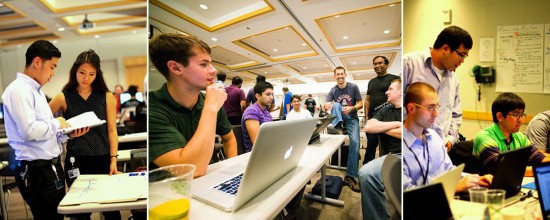

Teams, Judges, Finalists & Winners
For HackIT III, we decided to change things a bit. Instead of rushed presentations in front of a panel of judges and an entire audience, HackIT III winners were decided by two-tier judging system. For the first tier -at the regional level -teams were set up in a expo fair fashion*, where several finalists were picked. Judges walked from table to table, relieving the high pressure of presenting in front of a large audience (You know those engineers, some can be quite shy!).This way, the teams were able to display all of their hard work at their own pace.
Judges at the San Jose, California site included John Manville, SVP Global Infrastructure Services, KC Wu, VP Customer Value Chain and Data Innovation, Mark Yolton, VP Marketing, Damian Muzzio, Director of Operations for Engineering, Randy Jewell, Distinguished IT Engineer Charlie Treadwell, Nagendra Prahalad, and Tony West. United Kingdom onsite judges included Colin Seward, Paul Andrews, Kieran Higgins and Trevor Langley Jones. Lastly, judges at the North Carolina site included George Talbot, Chris Cottrell, Michael Caines, and Joe Clarke.
After the first tier of judging, finalists from all regions were gathered, bringing Cisco's global talent together. These teams presented to another panel of distinguished judges, where the finalHackIT III winners emerged!
Congratulations to all of our finalists and global winners!
Featured Category Winner: Smartnet

From left to right: David Chen, Pushpinder Rattan, Angelica Monterrubio, Danish Chopra, Sid Chakravarthy
Networks these days are not smart enough to smell a possible incoming outage in times such as hurricanes, earthquakes, tsunamis, stock crash etc. Big social data can provide useful information about what's happening on the internet right now and give us information about an incoming disaster. Bird eye aims at combining the concepts of Big social data and Software defined networking to make networks intelligent, socially aware and adapt automatically to any changes required in the network before a disaster happens and continue the provision of uninterrupted services.
Open Category Winner: Charge Hive
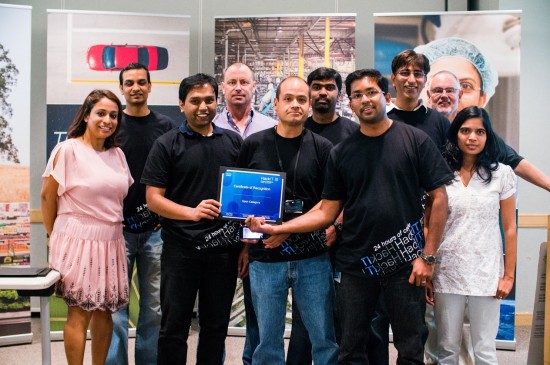
From left to right: Ajay Gatla, Pramod Sudheendra, Oscar Trampe, Maniyarsan Selvaraj, Pradeep Manivannan, Tarun Arora, Aruna Mandadi (not in picture: Pradeep Vorugu)
Currently there are 50 BLINK electric car charging stations in Cisco and over 300 cars (and growing fast). That's an average of 6 cars per station, and assuming 3 hrs per charge, that is 18 hrs of charge time per station. The result, people have to drive around to find a vacant spot or check back frequently. There are frequent arguments on who is next in queue to charge. WPR confirms that this is an issue and they get reports of people arguing over it. Charge Hive is a mobile app that addresses the issue by creating & automating queuing for charging stations. Users can check availability of charging stations in Cisco based on geo-location and check into a queue. The application maintains the queues and notifies users their position in Q and when it's their time to charge. It also alerts users when their charge is complete. The architecture uses Blink RESTful APIs to constantly monitor status of charging stations and builds a custom queuing system on top of it.
San Jose Featured Category Finalist: Help Desk Tweets
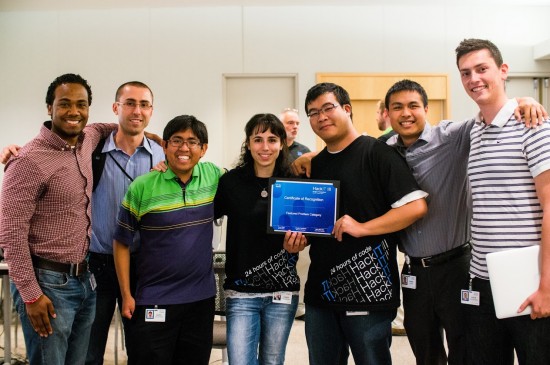
From left to right: Jerome Sanders, Alex Caughron, Darryl Delacruz, Lauren Falzarano, Alben Cheung, Roger Huang
Cisco IT Help Desk is a crowded sourced, social data driven, question and answer platform. Employees can post questions (complete with hash tag functionality) about issues or problems they're facing. Users can respond to questions with solutions, comments, and even up-votes to show relevance.In addition, users can specify areas of expertise and view a special stream where only relevant questions are shown. As a tech support platform, Cisco IT Help Desk is an immediate question and answer system that gives employees an alternative to GTRC, Remedy, and traditional mailers. As a result, it can lighten the load on GTRC and save Cisco money by reducing the number of calls, which costs roughly$20 per call. Cisco IT Help Desk also has the potential to allow users to follow devices that relay information such as temperature, power usage, or outages to the system. Lastly, this platform aligns with Cisco's vision of the Internet of Everything.
RTP Featured Category Finalist: Cisco Services/Products Analysts

From left to right: Usman Siddiqui, Vineet Labru, Jimil Patel Edgar Uribe (not in picture: Abigail Reilly, Pawan Canchi)
The idea of our project was to find out physical locations generating more interest in Cisco Network Academy and the training it offers. This information can be used by Network Academy to channel their resources in a better way and thereby creating an opportunity to increase the revenues. We collected the relevant data from tweets by people all over the world using the Twitter API (in future, other social networks can also be used as most of them provide their API). This data was then sorted in a database and a visual representation was created in Tableau.
UK Featured Category Finalist: Case + me
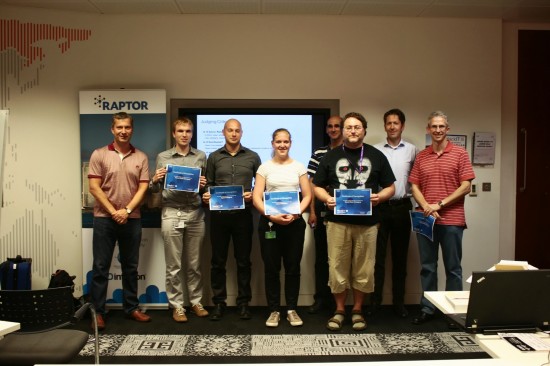
From left to right: Michiel Blokzijl, Luca Ambrosi, Charlotte Levin, Maarten Thibaut
On a typical Monday morning after a massive maintenance window, everyone's back in the office, and of course nobody can dial external numbers from their desk phones. Or, a critical engineering file system may be down, or salesforce.com may have been accidentally blocked by a new firewall feature. People start asking around, "is this broken for you, too?", and after a few nods from colleagues, somebody raises a case. While the user raising the case suspects it's a wide-spread issue, he/she can't do much more than tell the analyst. After raising the case, the user can send the case ID to others that he/she thinks are affected, so that they can track the status. We've added a "+me" button to the case wrapper. Users can click this button, if the incident is affecting them. The number next to the button indicates how widespread the issue appears to be.
San Jose Open Category Finalist & San Jose People's Choice: xWeb

From left to right: Anshul Chhabra, Akhil Aggrawal, Dan DeMicco, Loyola Baskar, Murali Vytla, Alex Karaman
Imagine an Audio Privacy room which comes alive with just a touch from you and automatically join the APR to WebEx. Not only that, APR updates all the floor displays with the information that the APR is now occupied and much more!! IoE possibilities are endless! Our hack is that once you enter the APR room, then using the NFC sensor technology, room automagically places you into WebEx meeting -APR IP phone places you on WebEx audio, TV monitor joins the WebEx -all with a simple touch of your phone to NFC sensor! We also provide the floor display of all APR that shows the availability in any device.
RTP Open Category Finalist: Cafe to Cube
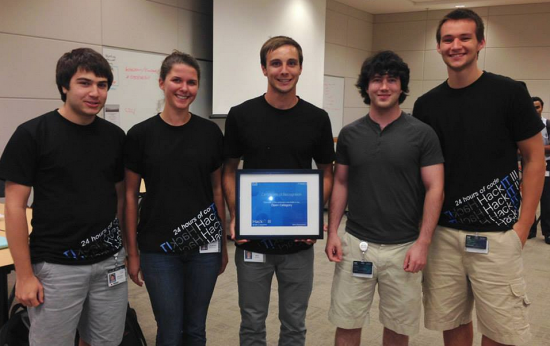
From left to right: Anthony Barbieri, Catherine Hastings, Mike Bazik, Sean Lyons, Patrick Wilson (not in picture: Kevin Yang)
Cafe to Cube is a powerful and simple to use web application that allows Cisco employees across the globe to order lunch in the cafe from their desk. As we designed the application we made sure to talk with stakeholders on what they wanted to see in the system. We found that a new point of sale application was being deployed and in the future we would like to integrate our application with that system. The application has 3 major use cases. The first would be the customer selecting their cafe and ordering the food they want to have. Another would be the chef having a queue of food to make from people ordering via the web. The final use case would be an admin interface to add additional items or adjust prices.
RTP People's Choice: Persona Labs
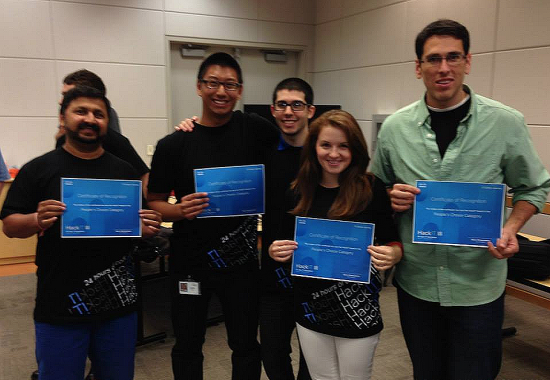
From left to right: Naresh Giri, Jason Kao, Mike Culato, Olga Ryzhikova, Wesley King (not in picture: Nick Conforti, Ronak Shah)
Persona Labs aims to enable valuable target audience insight for organizational decision making. By bringing together multiple data streams into a single source of truth for personas, Cisco could slice-and-dice employee information in a matter of minutes. For example, using data from internal directory searches, registered mobile user data, and employee location data, Persona Labs could display how many iPhone users there are in the European Cisco region that might use the new international transit app. The Persona Labs team developed application ideas to impact internal search, wide-scale communications, and app recommendation engines.
Other awesome projects:
HackIT Emoticons
Our group wanted to create more emoticons for Jabber to enhance the user experience. For designing our emoticons, we used Photoshop and paint.net. Then we hacked into the Cisco Jabber code, and inserted our own emoticons with its new code. We then created a WebEx Social Page so all Cisco employees can download our emoticons. Our fun emoticons include John Chambers with sunglasses, we hope this will encourage the use of Jabber. Our Work from Home emoticons offer practical ways of pinging to each other. Emoticons are gaining popularity for instant messaging in Facebook, iPhones, androids, Google Chat, GroupMe and more. Cisco can now follow suit with our additional emoticons for Cisco Jabber.
Cisco WaterCooler
Our project aimed to build a centralized portal for meet-ups, events, and other group-related activities. Currently, through IWE, Community Pages, or other external sites, it's hard to find an event related to what you want to do. Whether this is extra-curricular (photography, rock-climbing) or work-related (Cisco Live, Training Sessions), everything is scattered and hard to find. Cisco WaterCooler -our attempt at fixing that. Through a streamlined event creation interface and hookups to the CEC, Cisco employees could post and tag events in one centralized location or push original events from IWE/WxS/Outlook to the platform. From there, social data metrics can be calculated around event keywords to analyze impact, event availability, and ratings. Metrics can also be created, collating items such as "Top Events", "Most Talked About Events (on Twitter)", and other similar characteristics to analyze the marketing impact.
PowerPoint Clicker
We wanted to create a mobile app with which you would be able to control PowerPoint presentations from your phone while presenting. We found that there were many PowerPoint clickers that relied on Wi-Fi or Bluetooth to accomplish this task. We wanted to differentiate are app by making it work even if the person was not on the same Wi-Fi network as the PPT that was being shown.
Remedy Trends
Everyday users open up cases to track incidents that affect IT services. For Cisco, all of these cases are processed and stored in Remedy. Within a given time period there is some recurrence to the incidents logged in Remedy and a trend can be identified to create a picture of what services are constant pain points for IT's customers. Presently, analysis is done on structured data fields which helps identify problem areas reactively. In order to create a more proactive approach, the free text fields within Remedy need to be processed to create a map that can help identify how different key words trend and relate to a particular IT service. The heart of this HackIT project was to create a tool that processes the free text fields and present them in an intuitive and useful way to perform analysis.
Regional HackITs

From left to right: North Carolina site participants, United Kingdom site participants
This blog post was written by Lalli Flores. Blog post contributors include Josh Beren, Michael Hopps, Anthony Vu, Ben Varghese, Ramya Kandasamy, Sergios Charalambous, Keith Proseus, David Christman and Jyoti Sarin.
 Etiquetas calientes:
innovación
IT
hackathon
hackit
Etiquetas calientes:
innovación
IT
hackathon
hackit